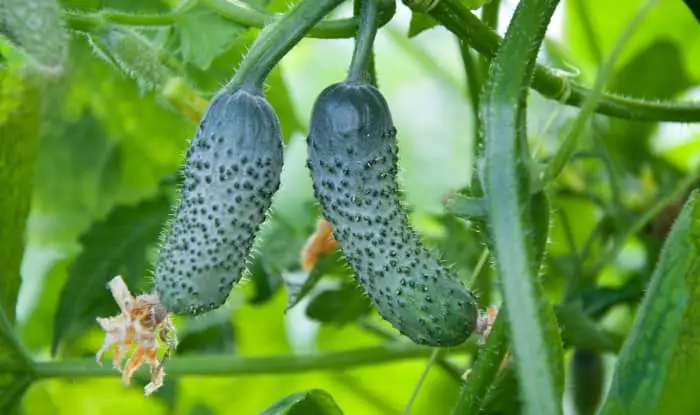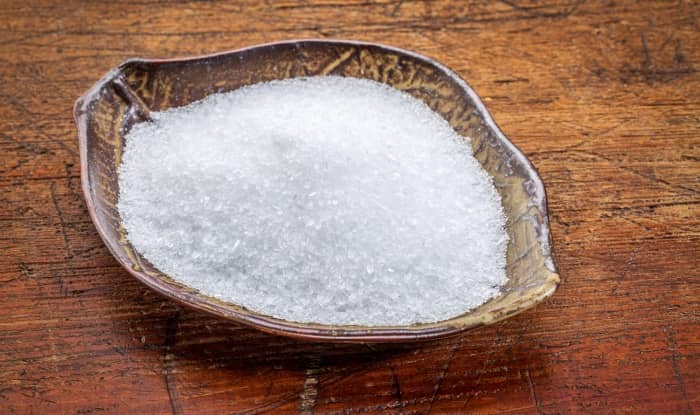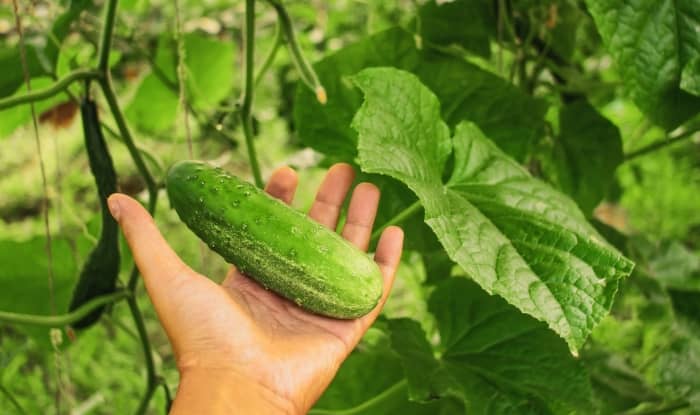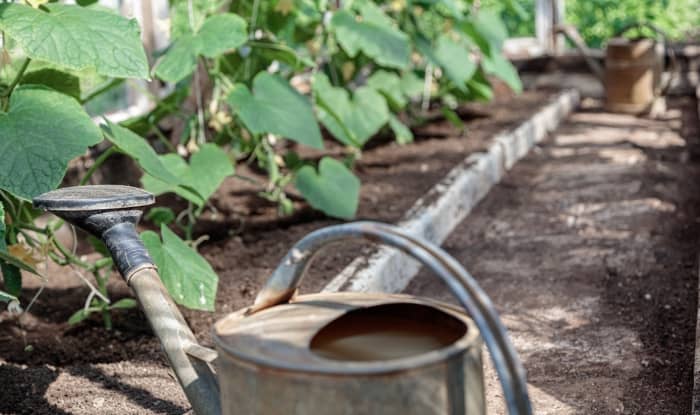Using Epsom salt for cucumbers helps you to get better results.
But only when it’s used correctly.
You see, it’s one of the quickest and easiest ways of making sure your plants have enough magnesium and sulfur.
But it can also harm them if you overdo it.
So in this article, we show you why, how, and when you should use it.
Let’s dive in.
Why Should You Use Epsom Salt For Cucumber Plants?
Epsom salt is also known as magnesium sulfate and has the chemical formula MgSO4.
As Epsom salt contains both magnesium and sulfur it’s useful when you add it to the soil to cure deficiencies in either or both of those two elements.
This is important because, without these essential nutrients, your plants will develop health problems.
Let’s take a look at what these nutrients do and why using Epsom salt can help your plants to grow more successfully.
Magnesium
Magnesium is essential for the production of chlorophyll, which gives leaves its green color and has a key role in photosynthesis, the process by which plants turn sunlight into energy they can use.
Consequently, it’s important for normal growth. If the plant can’t get as much as it would like then you might see a decrease in your cucumber yield.
But the first symptom of a deficiency will be the older leaves on the plant turning yellow as they lose chlorophyll, a process called chlorosis. The lower leaves are the first affected, as the magnesium is used up by the new growth.
You’ll notice the yellowing appearing between the major veins of the leaves. And a light tan burn will eventually develop, leading to tissue death in severe cases. But the green veins will still be visible.
Magnesium deficiency is common in light, sandy, and acidic soil. Often in areas that get a lot of rain that leaches it from the ground.
And if you’re growing in a high tunnel or a container, keep an eye out, because deficiencies are particularly common, often appearing from mid-to-late season.
High levels of potassium and ammonium also lead to a reduction in magnesium in the soil. So be careful when choosing a fertilizer.
Sulfur
Sulfur is needed for essential amino acids and coenzymes in your cucumber plants.
A lack of sulfur first becomes evident in new leaves and is visible as a yellowing of the foliage.
You can distinguish it from other deficiencies that cause chlorosis because the leaf veins don’t stay green.
When Should You Apply Epsom Salt To Cucumber Plants?
Some people have their soil tested so they can accurately find out the mineral composition and whether or not they need to add any nutrients.
But most people aren’t that precise about things, and just add a bit of fertilizer to their cucumber plants and then watch how they develop.
During the growing season, if you notice the signs of a lack of magnesium or sulfur as your plants grow, then you can try adding some Epsom salt.
Even if they’re not showing signs of deficiency, giving the soil a boost with Epsom salt can improve your results. As long as you don’t overdo it.
How Often Do You Treat Cucumbers With Epsom Salt?
Usually, one dose of Epsom salt midseason is enough to keep your cucumber plants happy, unless they show signs of deficiency.
If you’re growing them in a pot, give them a dose every 4-5 weeks if you start to notice the symptoms.
If you’re growing in the ground in your vegetable garden, using Epsom salt every 4-6 weeks should be enough.
Can You Use Too Much?
Yes, it’s important not to use Epsom salt too often. So don’t use it like a fertilizer. If you use it too regularly you’re likely to harm and maybe even kill your plants.
You’ll notice them start to wilt and visible signs of damage can appear on the cucumber leaves as they dry out, with white crusty patches developing.
How Do You Use Epsom Salt For Cucumbers?
How much Epsom salt for cucumbers should you use?
And how should you apply it?
There are 4 main ways of using Epsom salt on your cucumber plants:
- When you’re watering
- As a foliar spray
- As a side dressing
- When you’re first planting
Let’s take a look at the best way to do each of these:
Watering
The most common way of adding Epsom salt to your cucumber plants is by mixing it with water and using it when you’re watering.
- Mix 1 tablespoon of Epsom salt per 1 gallon of water. Make sure the mixture is well stirred so that the Epsom salt is completely dissolved.
- Add the Epsom salt solution to a watering can and use it when it’s time to water your plants.
Foliar Spray
To use Epsom salt as a foliar spray you’ll need a handheld garden sprayer.
The idea is for the cucumber plant to absorb the nutrients through its leaves instead of its roots. So you need to get in close and make sure they get good exposure to the Epsom salt solution.
This doesn’t replace watering the plant as per your usual schedule and is just a method for helping the plants to obtain missing nutrients.
- In 1 gallon of water add 2 tablespoons of Epsom salts.
- Mix them together well and pour into your spray bottle.
Side Dressing
This is a less common approach than the previous two, but it couldn’t be quicker or easier.
All you do is sprinkle a couple of tablespoons of Epsom salt near the base of your cucumber plant.
This is best-done midseason to give your cucumber plants a boost.
When First Planting
If you already know the soil is magnesium deficient, you can prepare it while planting your cucumber seedlings by adding Epsom salt.
Mix 1-2 tablespoons with the soil as you plant them. Alternatively, you can mix Epsom salt with your fertilizer before applying it.
Conclusion
Whether you’re container gardening or growing vegetables in the ground it’s a good idea to watch your garden plants for any signs of nutrient deficiency.
Cucumbers grow well when they have a good supply of all the primary, secondary, and trace nutrients.
Using Epsom salt is a quick and easy way of correcting magnesium and sulfur deficiencies and giving your cucumber plants a boost.
And as it’s considered organic, it’s a good choice for organic gardening.
As well as cucumbers, you can try using Epsom salt for tomato plants, zucchini plants, and squash.
If you have anything to add to these gardening tips, please leave a comment below.




Hi thanks for the article! I’m going for the foliar spray method. Please could you let me know how often to apply for this method? Also can I check it isUS gallons not UK? I presumed US as it’s .com. Thanks again, best wishes Katie
Hi Katie,
Yes, US gallons.
Try spraying the plants when they bloom and watch to see how they respond. You can try it again around 10 days later.
Try to cover the leaves in a fine mist, in particular the undersides.
It’s best done in the morning or evening when the air is cool.